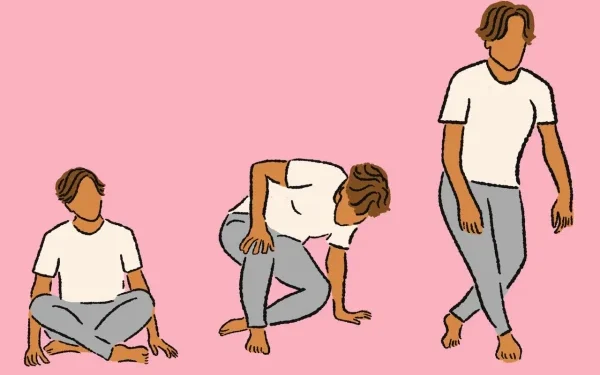A simple sit-to-stand test — requiring no special equipment or medical knowledge — could offer a powerful prediction of how long a person might live. According to a long-term study conducted by exercise medicine researchers in Brazil, this home-based functional movement test may be an important indicator of health and lifespan, especially among middle-aged and elderly individuals.
The findings were published in the prestigious European Journal of Preventive Cardiology, and they shed light on the close relationship between physical fitness, mobility, and longevity.
The Sit-to-Stand Longevity Test: What It Is and How It Works
Test Description
The sit-to-stand test, also known as the sitting-rising test (SRT), evaluates a person’s non-aerobic fitness, including muscle strength, balance, coordination, and flexibility. It is performed by asking an individual to sit on the floor from a standing position and then stand back up — all without the aid of hands, arms, or knees for support.
Participants are graded on a 10-point scale:
- 5 points for sitting down,
- 5 points for standing up,
- One point is subtracted for each use of a hand, knee, forearm, or side of the leg for support.
A score of 10 indicates optimal mobility and physical independence, while a score of zero indicates severe limitations.
The Study: A Decade-Long Investigation into Longevity
Participant Overview
The study was conducted by researchers at the Exercise Medicine Clinic in Rio de Janeiro, Brazil, and involved 4,282 adult participants aged between 46 and 75 years, most of whom were men. The researchers tracked participants over a 12-year period, monitoring their health conditions, test scores, and mortality outcomes.
Each participant underwent a full medical assessment and then performed the sit-to-stand test. Their results were compared with survival data gathered over the next 12 years.
Key Findings
The results of the study were compelling:
- Participants who scored 8 or more points had a significantly lower mortality risk over the next 12 years.
- Those who scored 3 or fewer points had a five to six times higher risk of death compared to those with the highest scores.
- Participants who scored a perfect 10 were overwhelmingly still alive 12 years later.
The study concluded that the sit-to-stand test is a strong predictor of longevity, independent of age, gender, and BMI.
Why This Test Works: Science Behind the Movement
Physical Function as a Health Marker
The ability to sit and rise from the floor without assistance is closely associated with several physiological systems that deteriorate with age, including:
- Musculoskeletal strength: Indicates the condition of leg, hip, and core muscles.
- Joint flexibility: Important for everyday movements and fall prevention.
- Balance and coordination: Critical to avoid injuries from falls, especially in the elderly.
Unlike standard cardiovascular tests, the sit-to-stand test focuses on non-aerobic fitness, which is just as important for overall health.
A Reflection of Independence
The ability to perform this task without assistance also correlates with a person’s functional independence. People who require help in this movement are more likely to need support in other daily activities and are at greater risk of hospitalization and morbidity.
Benefits of the Sit-to-Stand Test
1. Ease of Use
- Requires no equipment or medical supervision.
- Can be done at home by individuals of most age groups.
2. Early Detection
- Identifies hidden issues such as muscle weakness, impaired balance, or early joint stiffness that might not show up in conventional health checkups.
3. Preventive Health Tool
- Encourages individuals to improve their physical fitness through strength and flexibility exercises if they score low.
4. Accessible to Everyone
- Ideal for elderly populations or those who don’t have regular access to gyms or medical testing facilities.
How to Do the Sit-to-Stand Test at Home
You can perform the test in a quiet area of your home with the following steps:
- Wear comfortable clothes and ensure a clean floor surface.
- Stand upright and cross your legs.
- Attempt to sit down slowly without using your hands, arms, or knees.
- Once seated, stand back up again — again, without assistance.
- Each time you use a hand, knee, or need external support, subtract 1 point.
- Total your score out of 10.
If you score below 6 points, it’s a good idea to consult with a physician or physical therapist to assess your mobility and potential risks.
Limitations and Considerations
While the test offers impressive predictive capabilities, experts caution that it should not be used in isolation to judge a person’s health. It is not a replacement for full medical diagnostics, and certain conditions — such as arthritis, previous injuries, or neurological disorders — may affect the outcome unfairly.
Additionally, older adults should attempt the test cautiously or under supervision, especially if they have issues with balance or are at risk of falling.
Implications for Public Health and Preventive Medicine
A Shift Toward Functional Assessments
This study supports a growing emphasis in medicine on functional fitness as a key measure of health — alongside traditional indicators like cholesterol, blood pressure, and blood sugar levels. The ability to perform basic movements is increasingly being linked to long-term quality of life and survival.
Potential for Global Adoption
Healthcare providers, especially in resource-limited settings, can use the sit-to-stand test as a cost-effective screening tool for identifying individuals at risk of frailty, falls, or early mortality.
Conclusion: A Simple Test with Life-Saving Potential
The sit-to-stand test offers a simple yet powerful glimpse into a person’s overall physical health and potential longevity. With no equipment required and minimal risk involved, it is an effective screening tool for people aged 40 and above to monitor their musculoskeletal health.
As societies grapple with aging populations and increasing rates of chronic diseases, such low-cost, preventive strategies could become essential in promoting healthy aging and independence in later life.
Whether used at home or in a clinical setting, the sit-to-stand test is a reminder that everyday physical ability is deeply tied to our long-term health — and that even small steps toward improving strength, balance, and flexibility can make a big difference.

























